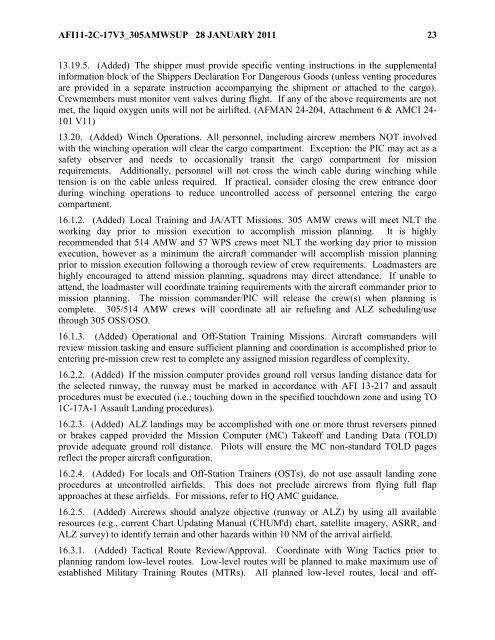BY ORDER OF THE COMMANDER 305TH AIR MOBILITY WING ...
BY ORDER OF THE COMMANDER 305TH AIR MOBILITY WING ...
BY ORDER OF THE COMMANDER 305TH AIR MOBILITY WING ...
You also want an ePaper? Increase the reach of your titles
YUMPU automatically turns print PDFs into web optimized ePapers that Google loves.
AFI11-2C-17V3_305AMWSUP 28 JANUARY 2011 23<br />
13.19.5. (Added) The shipper must provide specific venting instructions in the supplemental<br />
information block of the Shippers Declaration For Dangerous Goods (unless venting procedures<br />
are provided in a separate instruction accompanying the shipment or attached to the cargo).<br />
Crewmembers must monitor vent valves during flight. If any of the above requirements are not<br />
met, the liquid oxygen units will not be airlifted. (AFMAN 24-204, Attachment 6 & AMCI 24-<br />
101 V11)<br />
13.20. (Added) Winch Operations. All personnel, including aircrew members NOT involved<br />
with the winching operation will clear the cargo compartment. Exception: the PIC may act as a<br />
safety observer and needs to occasionally transit the cargo compartment for mission<br />
requirements. Additionally, personnel will not cross the winch cable during winching while<br />
tension is on the cable unless required. If practical, consider closing the crew entrance door<br />
during winching operations to reduce uncontrolled access of personnel entering the cargo<br />
compartment.<br />
16.1.2. (Added) Local Training and JA/ATT Missions. 305 AMW crews will meet NLT the<br />
working day prior to mission execution to accomplish mission planning. It is highly<br />
recommended that 514 AMW and 57 WPS crews meet NLT the working day prior to mission<br />
execution, however as a minimum the aircraft commander will accomplish mission planning<br />
prior to mission execution following a thorough review of crew requirements. Loadmasters are<br />
highly encouraged to attend mission planning, squadrons may direct attendance. If unable to<br />
attend, the loadmaster will coordinate training requirements with the aircraft commander prior to<br />
mission planning. The mission commander/PIC will release the crew(s) when planning is<br />
complete. 305/514 AMW crews will coordinate all air refueling and ALZ scheduling/use<br />
through 305 OSS/OSO.<br />
16.1.3. (Added) Operational and Off-Station Training Missions. Aircraft commanders will<br />
review mission tasking and ensure sufficient planning and coordination is accomplished prior to<br />
entering pre-mission crew rest to complete any assigned mission regardless of complexity.<br />
16.2.2. (Added) If the mission computer provides ground roll versus landing distance data for<br />
the selected runway, the runway must be marked in accordance with AFI 13-217 and assault<br />
procedures must be executed (i.e.; touching down in the specified touchdown zone and using TO<br />
1C-17A-1 Assault Landing procedures).<br />
16.2.3. (Added) ALZ landings may be accomplished with one or more thrust reversers pinned<br />
or brakes capped provided the Mission Computer (MC) Takeoff and Landing Data (TOLD)<br />
provide adequate ground roll distance. Pilots will ensure the MC non-standard TOLD pages<br />
reflect the proper aircraft configuration.<br />
16.2.4. (Added) For locals and Off-Station Trainers (OSTs), do not use assault landing zone<br />
procedures at uncontrolled airfields. This does not preclude aircrews from flying full flap<br />
approaches at these airfields. For missions, refer to HQ AMC guidance.<br />
16.2.5. (Added) Aircrews should analyze objective (runway or ALZ) by using all available<br />
resources (e.g., current Chart Updating Manual (CHUM'd) chart, satellite imagery, ASRR, and<br />
ALZ survey) to identify terrain and other hazards within 10 NM of the arrival airfield.<br />
16.3.1. (Added) Tactical Route Review/Approval. Coordinate with Wing Tactics prior to<br />
planning random low-level routes. Low-level routes will be planned to make maximum use of<br />
established Military Training Routes (MTRs). All planned low-level routes, local and off-
















